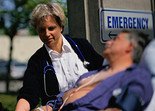血氧正常的COPD患者可不吸氧
丹麦学者的一项研究显示,门诊吸氧(AO)对于慢性阻塞性肺疾病(COPD)参与肺康复、经历极端劳累且没有严重休息低氧血症的患者并不提供额外的好处。相关论文发表于《慢性呼吸疾病》杂志(Chronic Respiratory Disease)。
研究者纳入血氧正常参与门诊肺康复(PR)治疗的COPD患者,让他们进行耐力穿梭步行测试(ESWT)。在165例符合要求的患者中,仅有45例愿意参加研究。在锻炼过程中,随机分为对照组(n= 23)或AO组(使用便捷式吸氧每分钟2L,n= 22)。PR包括监督培训20周,之后没有监督每天在家培训13周。
结果显示,在ESWT期间补充氧气可以将血氧饱和度提高2.3% (95% CI: 1.2%–3.5%; p< 0.001)。在33周的研究期间,分别有10和6位患者从AO组和对照组退出。患者平均每周花7.9小时吸氧。7周后,进行PR的患者ESWT可以延长为18,076秒(95% CI:101–258秒;p<0.001),St. George’s呼吸问卷(SGRQ)得分增加2.6(95% CI: 0.1–5.1秒;p=0.04),这种变化可以持续33周。33周中,AO组和对照组之间ESWT变化(223对241秒; p= 0.32)、SGRQ变化(−3.6对−4.5, 0.91)、COPD患者急性恶化人数、医院收治或出院人数均无显著差异。
The long-term effect of ambulatory oxygen in normoxaemic COPD patients: A randomised study.
Aim
To study the long-term benefits of ambulatory oxygen (AO) in combination with pulmonary rehabilitation (PR) in chronic obstructive pulmonary disease (COPD) patients experiencing exertional desaturation.
Patients and methods
Normoxaemic COPD who participated in outpatient PR and desaturated >4% and <90% during endurance shuttle walk test (ESWT) were randomised to control (n = 23) or AO 2 L/min from a portable oxygen concentrator (n = 22) to be used during exercise. PR consisted of supervised training for 20 weeks combined with unsupervised daily training at home followed by 13 weeks without supervised training.
Results
Only 45 of 165 eligible patients wanted to participate. Mean forced expiratory volume in 1 s = 32% (SD 13.8) and Medical Research Council (MRC) = 4.5 (3-5). Supplemental oxygen improved oxygen saturation during ESWT by 2.3% (95% CI: 1.2%-3.5%; p < 0.001). In the study period of 33 weeks, 10 and 6 patients withdrew from the AO group and control group, respectively. Patients spent an average of 7.9 h/week on oxygen. PR improved ESWT by 18,076 s (95% CI: 101-258 s; p < 0.001) and St. George's Respiratory Questionnaire (SGRQ) score by 2.6 units (95% CI: 0.1-5.1 s; p = 0.04) after 7 weeks, and these gains remained at 33 weeks of evaluation. There were no differences between the AO group and control group at 33 weeks of evaluation with regard to change in ESWT (223 vs. 241 s; p = 0.32), change in SGRQ (-3.6 vs. -4.5 units, 0.91), and number of patients with acute exacerbation in COPD (AECOPD), hospital admission or dropout (17 of 22 vs. 20 of 23, p = 0.59).
Conclusions
AO seems not to provide additional beneficial effects in patients with COPD participating in pulmonary rehabilitation and experiencing exertional desaturation without severe resting hypoxaemia.
 此主题相关图片如下:1.jpg
此主题相关图片如下:1.jpg